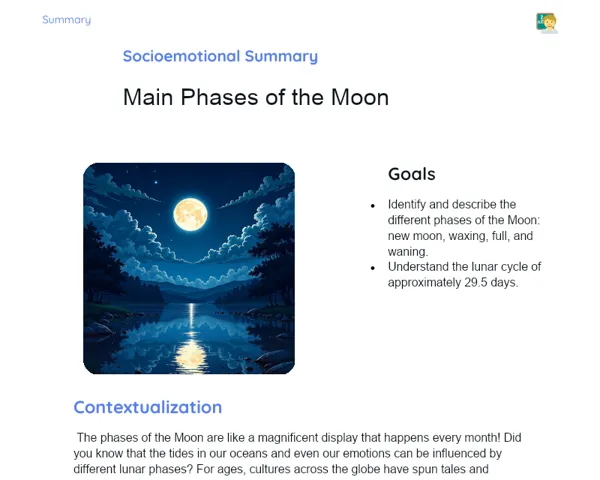Summary Tradisional | Waves: Introduction
Contextualization
Waves are an integral part of our everyday life, playing a key role in the transmission of energy. Whether it's the sound we hear or the light we see, waves are behind many natural and technological phenomena. Essentially, they are disturbances that travel through a medium – like air or water – or even in a vacuum, as is the case with electromagnetic waves. By understanding how waves work, we can apply this knowledge in various practical fields such as telecommunications, medicine, and engineering.
There are several types of waves, each with its own characteristics. For example, mechanical waves, like those producing sound, need a material medium to move through, whereas electromagnetic waves like light can travel in a vacuum. Moreover, waves are either transverse—where the oscillation is at a right angle to the direction of travel—or longitudinal—where the oscillation is in the same direction as the wave motion. Recognising these differences is crucial to understanding how waves behave and interact with their surroundings.
To Remember!
What are Waves?
Waves can be described as disturbances that travel through a medium or even in a vacuum, carrying energy without moving matter from one place to another. They appear in many forms, from the light that brightens our day to the sound that reaches our ears. Essentially, waves propagate by transferring energy from one particle to the next in a chain reaction.
This propagation can occur in solids, liquids, or gases, and even in a vacuum when it comes to electromagnetic waves. The energy carried by a wave – its intensity and frequency – directly affects its behaviour and impact on the medium.
Grasping the concept of waves is important for its applications in fields like telecommunications (including mobile connectivity), medical imaging, and engineering. For instance, studying sound waves is key for developing communication systems, while understanding electromagnetic waves underpins the transmission of radio, TV, and internet signals.
-
Waves are disturbances that travel through a medium or in a vacuum.
-
They transfer energy without carrying matter along.
-
They manifest in various forms, such as light and sound.
Classification of Waves
Waves are broadly classified into two types: mechanical waves and electromagnetic waves. Mechanical waves, such as sound waves, require a material medium (solid, liquid, or gas) to propagate, whereas electromagnetic waves, like light, can travel in a vacuum.
Within these major categories, waves can be further classified into transverse and longitudinal waves. Transverse waves exhibit oscillations that are perpendicular to the direction of travel – think of the ripples on a rope. In contrast, longitudinal waves show oscillations in the same direction as they travel, as is the case with sound waves.
Understanding these classifications is essential to appreciate how waves interact with their environment and how they are applied in practical situations, whether in communication technologies or in medical diagnostics.
-
Mechanical waves need a material medium to propagate.
-
Electromagnetic waves can travel in a vacuum.
-
Transverse waves oscillate perpendicular to the direction of travel.
-
Longitudinal waves oscillate parallel to the direction of travel.
Transverse and Longitudinal Waves
Transverse waves are characterised by oscillations that occur at right angles to the direction in which the wave propagates. For instance, when you see a wave traveling along a rope, the individual points on the rope move up and down, despite the wave moving horizontally.
On the other hand, longitudinal waves have oscillations along the same direction as the wave’s travel. A common example is a sound wave where particles in the medium alternate between compressions and rarefactions.
Understanding the difference between transverse and longitudinal waves is vital for comprehending how various types of waves behave in different media, which in turn is fundamental for their application in real-life scenarios, such as in audio technologies and ultrasound imaging in medicine.
-
Transverse waves have oscillations perpendicular to the direction of travel.
-
Longitudinal waves have oscillations parallel to the direction of travel.
-
Examples include rope waves (transverse) and sound waves (longitudinal).
Wave Speed
The speed of a wave is determined by the formula v = f * λ, where v is the wave speed, f is the frequency, and λ is the wavelength. This equation implies that the speed of the wave is directly related to both its frequency and its wavelength.
Frequency is defined as the number of oscillations occurring each second, measured in Hertz (Hz). Wavelength, on the other hand, is the distance between two consecutive points in the wave that are in phase, such as two peaks.
Knowing how to calculate wave speed is important for a range of applications, from the transmission of radio and TV signals in telecommunications to the use of ultrasound in medical diagnostics.
-
Wave speed is given by the formula v = f * λ.
-
Frequency is the number of oscillations per second (measured in Hertz, Hz).
-
Wavelength is the distance between successive in-phase points on the wave.
Key Terms
-
Waves: Disturbances that travel through a medium or vacuum, carrying energy.
-
Mechanical Waves: Waves that require a material medium to propagate.
-
Electromagnetic Waves: Waves that can propagate in a vacuum.
-
Transverse Waves: Waves with oscillations perpendicular to the direction of travel.
-
Longitudinal Waves: Waves with oscillations in the same direction as they travel.
-
Wave Speed: Determined by the formula v = f * λ, where v is speed, f is frequency, and λ is wavelength.
-
Frequency: The number of oscillations per second, measured in Hertz (Hz).
-
Wavelength: The distance between two consecutive in-phase points on a wave.
Important Conclusions
In this lesson, we have explored the concept of waves, learning that they are essentially disturbances that travel through a medium or even in a vacuum while transferring energy without moving the matter itself. We have seen that waves can be classified into mechanical and electromagnetic types, with mechanical waves needing a medium to propagate and electromagnetic waves capable of travelling in a vacuum. Additionally, we have unpacked the differences between transverse and longitudinal waves by looking at their unique characteristics and examples.
We also studied the wave speed formula, v = f * λ, to understand how frequency and wavelength work together to determine the speed of a wave. This is critical knowledge with practical applications in areas like telecommunications and medical imaging.
The study of waves is significant given its wide-ranging applications in everyday technology – from radio and internet communications to medical procedures such as ultrasound imaging. I encourage everyone to delve deeper into this topic and find ways to apply this understanding in academic and practical settings.
Study Tips
-
Revise the fundamental concepts of waves and their classifications using examples and diagrams to bolster understanding.
-
Practice calculating wave speed with various frequencies and wavelengths to build confidence in using the formula v = f * λ.
-
Explore additional resources like videos and articles on the practical uses of waves in telecommunications and medicine to gain a broader perspective.



